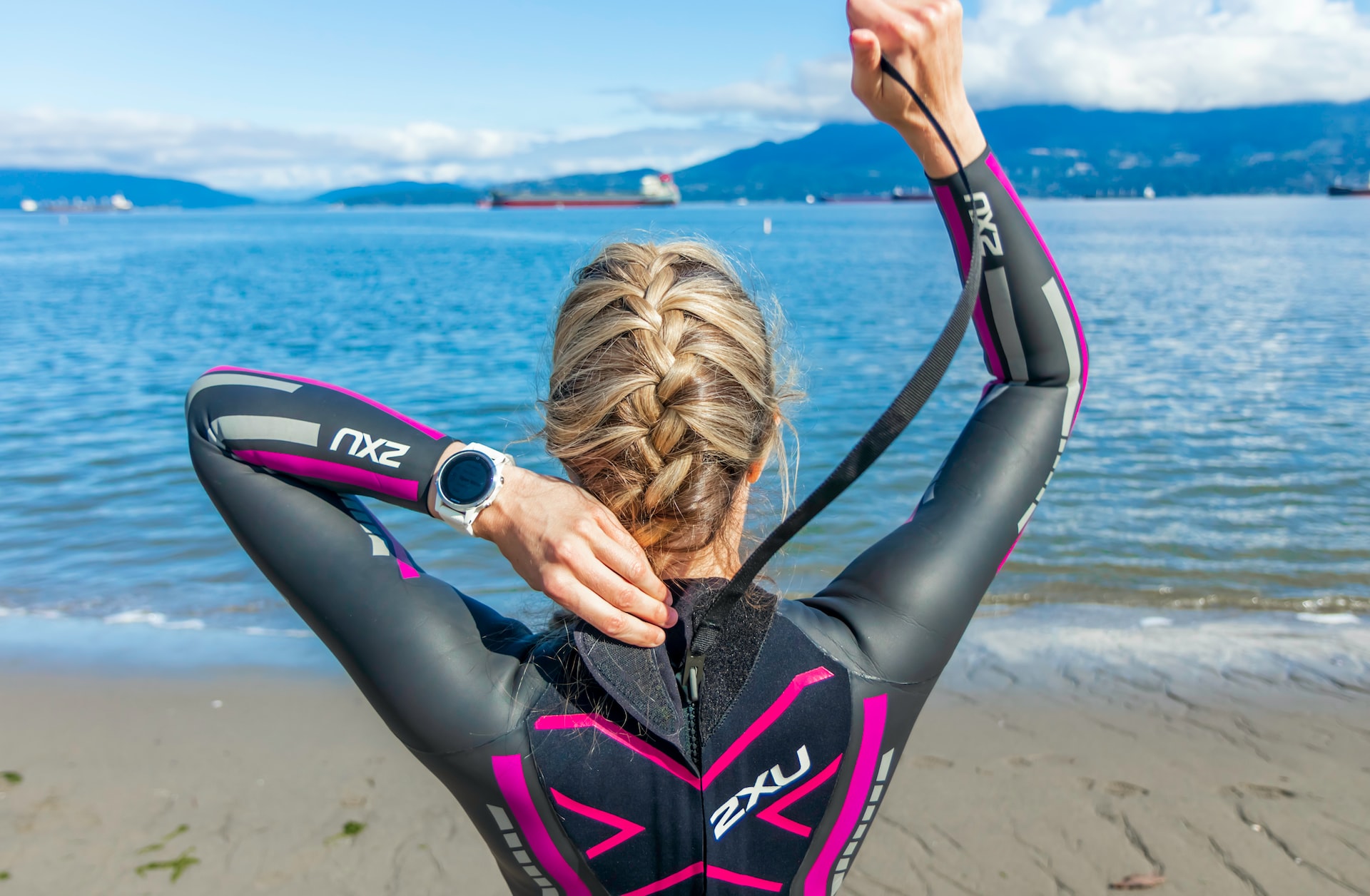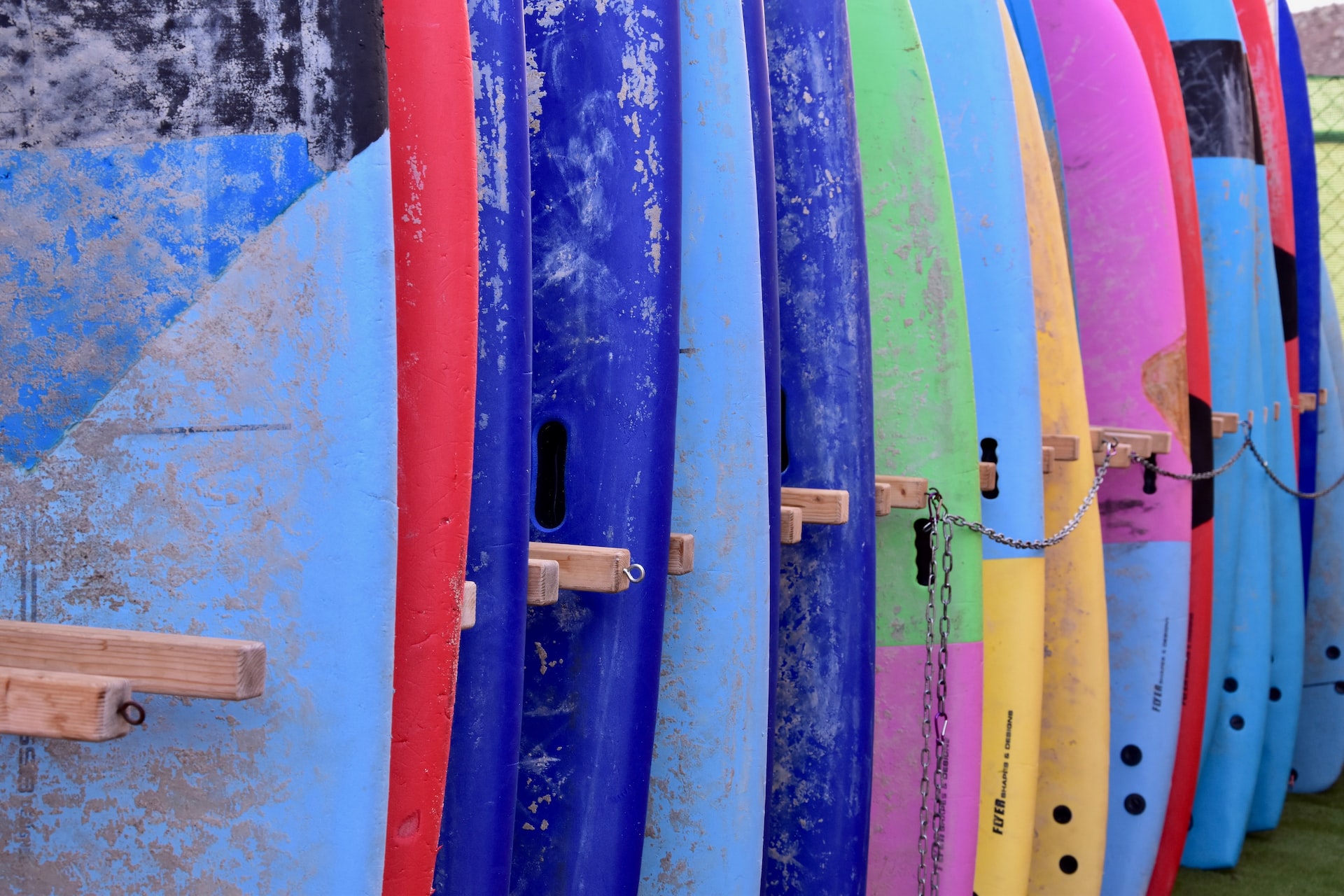Anyone who’s spent time out on the water knows the importance of maintaining the integrity of a surfboard and wetsuit. Summer activities and trips to the surf club are more fun with well-cared-for water sports equipment. Read on for some expert tips on how best to maintain and store your surfing gear.
Table of Contents
Common mistakes when taking care of your surf equipment
Maintenance and cleaning tips
Without regular care and proper storage, a surfboard loses its best performance features. It may become waterlogged, lose its texture, or even become dangerous. Your wetsuit needs proper care to retain its waterproof features and prevent odor.
Before heading out to surf, check the board carefully for dents or compression marks. Address any damages before you head into the waves. If your board needs work, take it to get fixed as soon as possible.

What is your best advice for waxing a surfboard?
Waxing up a new board or re-waxing an old favorite should be an enjoyable moment as you prepare for the good times and waves that await. There are a few key tips to ensure that your wax does the job and looks good.
The proper wax job on your surfboard starts with preparation. First, have the correct wax for the temperature range you plan to surf in. These range from Extra Cold (think Alaska) to Tropical for surfing in warm water. Next is deciding where you will be when you wax up. You’ll want to apply the wax in a cool and shady place. Wax melts, smears and will be ruined in the sun. If the board is in a cool space, the wax will adhere in nice bumps and ridges, creating a lasting grip for your feet.
For in the finale, lay that wax on your board in a circular motion all over it, never putting too much pressure on the bar of wax in hand not to smear it. A repetitive circular motion all over the deck will achieve your goal. Take your time. The last step is to keep it clean and not ruin your masterpiece by getting sand in it or leaving it in the sun to melt.
Dylan Sohngen at Aqua Surf
What is your best advice for waxing a surfboard?
Step 1: Dirt & Grime Removal
Use turpentine, white spirits, or a wax remover to prep the deck of your surfboard and remove all dirt and grime.
Step 2: Wax selection
The type of wax you use will vary depending on the temperature of the water you’re surfing in. If you’re surfing in warm water, you’ll use harder wax; in cold water, you’ll need a softer wax. Choose the type of wax for the climate.
Step 3: Wax Application
Apply wax to your surfboard in the following way:
• Diagonal lines
• Horizontal lines
• Vertical lines
Rinse and repeat the above until small bumps are formed. Once bumps have been created, continue the wax application in a circular motion. Keep going until pronounced bumps of wax have formed on the board’s deck.
* Pro tip: Some surfers add a harder wax as a base coat. This is done to reduce any give/movement in the wax underfoot. Not essential, but something to consider.
Rowan at House of Surf
How to store your surfboard for traveling?
Firstly, remove all the wax on your board, this is because you will need to apply suitable wax for the climate you are traveling to when you get there.
Next, remove your fins and leg rope so they don’t get damaged whilst traveling. Make sure you wrap some rubber bands or tape around your set of fins when you remove them, so you don’t lose any while traveling.
You may also like to use pipe insulation (hollow soft foam tubing) or similar to protect the rails of your board. Cut a slit lengthways so you can wrap it around the rail of your board.
To help protect your board in transit, you can use bubble wrap. Focus on the nose and tail the most, and as added protection, you can wrap your board with towels or a board sock cover.
If you’re packing more than one board, lay the largest one on the bottom with the other boards facing the same direction and the rockers running the same way.
Place your board/s in a firm-fitting travel board bag. Most board bags come with straps attached inside the bag. Do not place leg ropes, fins, or anything sharp or hard in your board bag (put them in your luggage bag).
Serena Adams, Founder & Coaching Director at Surf Getaways
Why you shouldn’t surf a board with open dings?
A surfboard’s longevity is dependent on being watertight. If water can enter the surfboard’s foam core, even through tiny hairline cracks, the water will cause damage to the foam core, softening and degrading it. It inevitably will deteriorate the foam-to-fiberglass bond, which is a key component of durability. This is important for surfing in freshwater, chlorinated water, or saltwater. Seawater also has tons of organic matter, which can worsen the effects. Getting water inside can also make the board heavier and denser, affecting the board’s float and performance. This is critical for surfboards of all construction types but especially important for EPS/Epoxy surfboards which have more airspace inside and can flood with water more easily. Some dings will be obvious, but others may be harder to notice, so it’s important to check your board regularly. If you find a small hairline crack, the “fingernail test” is a good metric to determine if it needs repair. It likely should be repaired if you can catch the crack with your fingernail. If you can’t catch it with your fingernail, it may just be a scratch or a subsurface crack which you should monitor and repair if it worsens.
Dave Kaminsky at Daveys Sky Surfboards
What is the most important thing about taking care of a surfboard?
Of course, there are many aspects that help to prolong the life and functionality of a board. But the most important is keeping it out of the sun, and the heat as this causes yellowing and delamination, which permanently damages your surfboard. Also, handle it carefully, so it doesn’t get dinged up. Suppose you do get a ding while in or out of the sea. It would help if you got it fixed straight away and did not go in the sea with it while it’s still got any cracks (as this would let water in). Keeping it in a board bag or board sock whenever you’re not using it will help keep it taken care of. And for travel tips, I’d always say pad it well in your board bag, with foam and clothing and that sort of stuff, mainly putting it around the nose and rails.
Emma at Hollow Tree’s Resort
What is your best maintenance tip for taking care of an electric surfboard?
By now, I’m sure you know that having an electric surfboard is not a “maintenance-free” experience, and given the high cost, you will want to ensure it lasts as long as possible. In short, salt water and an e-surfboard (especially batteries) are not the best of friends. That’s because salt water is corrosive. So, you need to ensure no salt is left after the ride. Even if you are surfing freshwater, you want to remove all the dirt.
Here are several cleaning and electric surfboard maintenance tips:
- If you notice the slightest dents or cracks, ensure you repair the board quickly.
- After using the board each, you need to flush the coolant water outlet with 1-3l of clean water. Also, please avoid high pressure.
- Wash with clear water and check for corrosion on the powerbox, PVS hull, fins, kill switch magnet with clean water, power connector, battery connector, jet drive, and pressure compensation valve. When dry, apply the contact spray that the manufacturer of your e-surfboard recommends.
- Before storing it in a surfboard bag, ensure everything is dry and clean. Double-check if all your connectors are dry before you plug them in again.
- Avoid keeping your e-surfboard in the heat and direct sun when not in use. What do I mean by that? While having your favorite drink with friends, avoid parking your e-surfboard in the sun.
- Also, when storing the e-surfboard over the winter, ensure you put it in an area where temperatures are not falling below 32 degrees Fahrenheit (0°C). Remove the battery when storing it over the winter (or for an extended period) and keep it charged consistently between 50-80%.
Antony Acutt at Get Foamie
How do you prevent a paddle board from getting damaged by salt water?
Saltwater and the sun can be very damaging as they can degrade the finish of a board over time. There are two types of board finishes; sand finish and gloss coat. You can normally tell the difference between them as a gloss coat has a much shinier finish than the sand finish, which has more of a matt or dull finish. Inflatables are a different story as they are made from a heavy-duty PVC material which will also degrade over time.
A sand finish board is basically a board without the final gloss coat applied to save on weight etc., but they are very porous and can attract a lot of dirt and grime because they are not totally sealed up and will gain a lot of water weight. (Water molecules are so microscopic that they penetrate and soak through the sand finish). Most performance surfboards and SUP’s are a sand finish these days, though the majority of longboards and Outrigger Canoes still have a gloss coat that protects and seals the surface from any water migration. Most manufacturers will tell you a sand finish makes the board faster and perform better (it also saves them money and time not applying the gloss coat) as the water molecules settle into the pores of the board, thus creating a water over water surface. Still, again over time, they will add a lot of water weight gain slowing the board down.
To sum things up, If you want your boards to last and perform better and have a very expensive carbon fiber race board with a sand finish or just any old board, I will apply a fresh coat of Xtreme Cream to the surface approximately every four to six months so the board will stay looking like new and perform as well as when you just got it off the rack at your local shop.
Erik Nordskog (OnIt Pro) at Sup Connect
What is your best advice for surfboard maintenance?
Rinsing your surfboard under the shower after each surf prevents the salt from drying on it and keeping it in good condition. Leaving your board in the sun can cause discoloration, so it’s best to store it in a dry, shaded place inside a surfboard bag or sock. Keeping the wax fresh is also a good idea, so melting it off every so often and rewaxing it. As well as, check your board for dings after each surf and ensure you get them fixed right away, as water can seep in, and the board can become waterlogged! So as tempting as it is to surf with a small ding, it’s essential always to get them repaired asap to maintain the longevity of your board!
Sparky from Sparky’s Surf School
Storage
Surfboards must be stored out of the sun and away from anything that might damage them. Use a surf bag to prevent any needless dings, or store it somewhere cool and dry, like the garage or basement. Avoid leaving your board where it might topple over or get exposed to the sun.

Wetsuits
Wetsuits get grungy if left neglected for too long. When you remove the wetsuit after your surf, steer clear of anything sharp that might get into your suit. When you get home, give it a good rinse with fresh water to remove salt and algae. Hang it to dry, but avoid direct sunlight.
Why do you recommend using a changing mat/bag to take care of a wetsuit?
Thomas Oretsky at iSurf
How to repair a wetsuit?
Wetsuits can be damaged easily from a fingernail to a fin during a wipeout or deterioration over time. However, with just a tube of glue, you can fix it. I like to use GEAR AID Aquaseal NEO, but you can use any neoprene cement.
You need to ensure your wetsuit it’s completely dry (at least in the area you will be repairing) for the glue to work, so hang it outside for a day or two. Squeeze out a good amount of glue onto both sides of the ripped neoprene. When the glue dries, it shrinks/evaporates quite a bit, so use a lot. Push both sides of the torn neoprene together, and hold it there for a few minutes until the glue cures enough to hold it. Wait 10 minutes, and add a final layer of glue. Before using your wetsuit, wait 24 hours for the glue to cure fully and keep it in a dry place.
If your wetsuit has a long rip, you can use dental floss and a sewing needle to “stitch” it together before you glue it. The floss holds the neoprene together, and the glue seals it, so it is watertight again.This simple tip should extend the life of your wetsuit, keeping more money in your pocket and more neoprene out of landfills.
Steve at Ho Stevie!
What is your best advice for taking care of a wetsuit?
Here are all the things you can do to take care of your wetsuits:
- After every session, rinse it with fresh water to remove the corrosive saltwater.
- Avoid putting it on a hanger when wet to avoid it stretching out. Instead, put the wetsuit on a horizontal bar and let it dry.
- Avoid all contact with the sun while drying to prevent it from becoming cardboard-like and stiff.
- Avoid all contact with hot water to prevent the suit’s seams from deteriorating and further prevent seam splitting.
- If your wetsuit has a back zipper, try your best to prevent the velcro from coming in contact with the wetsuit, as this will peel the jersey off the neoprene.
- Once the wetsuit begins to smell a little stinky, as all eventually do, clean it thoroughly by adding a small drop of vinegar & (preferably) an eco-friendly soft sensitive laundry detergent to a bucket of fresh cold water.
These are the most important steps to take care of your wetsuit. However, if you get a rip in your suit, you can always fix it with dental floss and some neoprene cement (you can find this in most surf shops). It’s also important to remember that most wetsuits have one-year warranty protection against manufacturer defects, so if something weird happens, feel free to ask a surf shop near you if it’s covered by warranty.
Rusty at Long Beach Surf Shop
What are the benefits of eco-friendly wetsuits?
The main benefit of choosing an eco-friendly wetsuit is the footprint we leave on our world. As surfers, we depend on mother nature; that’s the beauty of the sport. Having the ocean as our training facility is a privilege, but it comes with a responsibility that needs us to be very eco-conscious.
In the early days of surfing, choosing an eco-friendly wetsuit meant compromising on features just to be labeled “green.” Nowadays, the industry has way more knowledge and experience. New materials and the production process have eliminated this compromise and made it a matter of price.
New eco-friendly wetsuits are made of natural rubber such as limestone neoprene (known as Yamamoto neoprene) or Yulex® – a renewable and neoprene-free foam material derived from hevea trees.
Other small features to look for in a good eco-wetsuit are:
– water-based lamination glues that emit zero volatile organic compounds (VOCs),
– recycled linings, e.g., made of PET bottles,
– and dope dying as an environmentally friendly technology for dyeing wetsuits.
Eco-friendly wetsuits are generally more pricey, but they are as advanced as the regular- and old-school neoprene suits. Some would even call them better, as they have other benefits, such as using lightweight and flexible materials and having an overall longer lifespan.
“You no longer have to choose between comfort or contribution to the degradation of our climate – it simply comes down to choosing what’s best for our planet and oceans.”
Martin at Surfers Hype Magazine

Surfboards
When you get out of the water, give your board a good rinse with fresh water. Store it in a bag if you have one. If not, prop it up somewhere in the shade where the water can drain off easily.
It’s important not to leave your surfboard in direct sunlight, as the wax will melt. If you must leave it out on the beach, store it upside down and place something on top to shield it from the sun.
How to transport a surfboard by car?
The fastest way to take your surfboards is inside the car. It’s also the most common way to store your board if it’s a short drive.
Lay the passenger’s seat down, and slide the surfboards in from the boot or through the passenger’s door. The surfboard’s tail should rest on the floor of the passenger side, with the fins facing the roof.
Then, position the board to lay flat on the passenger’s seat.
The last step is to strap them in with the seat belt to protect your most precious passenger.
The second way to store your surfboards is the most common way for longer trips. You’ll need roof racks, high-quality straps, and a board bag or sock. If you don’t have a board bag, you may want to use foam protectors or towels to create a protective buffer between the hard roof rack and your surfboard.
Lay the protective buffer along the length of the roof racks and place the boards face down on said protective buffer with the noses pointing forward and fins facing the sky.
Then, affix the front part of the surfboards first by passing the strap over the boards, bringing it back under the roof rack, and through the clip.
Fasten firmly, but not so firmly that you risk damaging the surfboards, and either thread the excess strap through a window or tie it in a knot.
Repeat for the back strap to secure the surfboard’s rear part to the roof rack.
Tom at Go Surf Perth
How to store surfboards?
It is best to store surfboards in a cool, dry place away from direct sunlight to avoid sun damage and melting wax in higher temperatures. Board bags help protect from sunlight and avoid damaging the board.
Sean Walker at World Surfaris
How to prepare your surfboard for a surf lesson?
With hard-top surfboards, you should check the wax’s condition and ensure you have the proper wax, as there are different waxes for different water temperatures. Make sure you have it waxed up nicely to get a good grip.
About soft tops, some people wax them, and some people don’t. It’s not really necessary. We don’t do it with our surf school’s boards because it collects sand and can tear up the board much faster.
Other than that, check the board and ensure it’s in rideable condition. Check the fin boxes, ensure that the fin boxes are secure and there is no damage to the board, and ensure that all the screws are tight and there are no missing ones. Then attach a leash that is the proper size for your board. After you’re done surfing, it’s always a good idea to rinse your board thoroughly with fresh water to get all the salt and sand off. Some people take their leashes off and store their boards in a bag or sock to protect them. Also, whenever it’s out in the sun, you always want to ensure the top side of your board is down, so the sun is not heating up and melting the wax.
Stephen White at Fun Surf LA
Are there any specific cleaning or storage instructions for wooden surfboards to prevent damage?
Wooden surfboards are often used to surf and as art pieces for interior design projects. Wooden surfboards are much more durable than standard boards, and proper maintenance will ensure that your board lasts for generations.
- If you’re surfing your wooden surfboard, and it’s hollow-framed, always make sure to put the vent plug in right before you get in the water and remove it right when you get out.
- Always use a surfboard bag or sock to protect your board from scratches, dings, and UV rays.
- Rinse your equipment with fresh water after each session to remove salt and sand that can corrode the board’s surface.
- Check for dings, cracks, and fissures before and after the surf and repair them promptly to prevent water from entering the core and compromising buoyancy and strength. A wood board may be a little more challenging to repair, but the repair can often be more beautiful than the original, so talk to your wooden surfboard builder for advice or to do the repair.
- Keep it out of the sun when storing it or displaying it. If it’s hanging on the wall, put it in a location that doesn’t get hit by direct sun at all.
- Use water and a microfiber cloth to dust it and keep it clean.
David Dennis from Ventana Surfboards & Supplies

Extra equipment
Other equipment like paddleboards, kayaks, and canoes require the same treatment as your surfboards. Give everything a good rinse with clean water and let them dry somewhere out of the sun. Store these items inside the house in a cool, dry place or outside in the warmer months under a thick tarp or in the boathouse.
What are the most common mistakes when taking care of surf equipment?
Properly maintaining one’s expensive surfboard equipment is easy if you follow these (2) main principles. The first is surfboard storage. I cringe when I see people storing their surfboards outside and, making matters worse, in the sunshine. This is a quick and easy way to deteriorate your surfboard very quickly. A mistake often made by many. By storing outside in the elements, you are subjecting your board to fluctuating temperatures and direct sunlight (if applicable). This will reduce your surfboard’s life expectancy. The best solution, purchase a surfboard bag or “sock” to store your board in and keep your boards indoors in a controlled climate.
The second principle to follow is always to repair any dings, small or large, immediately. I’ve seen people in the past (including myself) put a sticker or shove wax into a small ding to try and keep water out so they can go surfing with their favorite board there and then. Mistake! Water will always find its way into your ding; from there, the damage will only be compounded. The best solution to abide by is when you have a ding, you repair it before that board ever touches the water again to ensure the board is watertight!
Keep those (2) principles in mind; your equipment will have a much longer life span.
Tim Marsh at Safari Surf School
What is your best advice for taking good care of your surf equipment?
Many people have a special connection to their favorite surfboards. Surfboards are expensive and require an environmentally unfriendly process to produce. For these reasons, it is best to take good care of your boards to keep them beautiful and functional for years. The most important factor to consider when storing surfboards is to keep them away from UV exposure. The UV light degrades the fiberglass over time, leaving the board brittle and discolored. Also, it helps to store and transport your surfboard in a padded board bag. It is a widely accepted fact that most dings happen outside of the water, and keeping your board protected at all times is an effective prevention measure. Thirdly, rinse your board with fresh water if you will not use it for a while. Over time, the salt water can oxidize and degrade the resin in the fiberglass, leaving your board with less structural rigidity than it otherwise would have. Finally, keep your board out of your car during the day if you live in a hot climate, even if it is in a board bag. The high temperature that can build up inside your car can warp your surfboard out of shape. Also, exposing your surfboard to regular heat cycles speeds up the degradation process.
Garrett Johnston at Padang Padang Surf Camp
How to take care of your paddle?
Stand-up paddleboarding (SUP) is a fun and popular water sport that allows you to explore and enjoy the great outdoors. A key piece of equipment for this activity is the paddle, which is used to propel the board through the water. Proper care and maintenance of your SUP paddle can help extend its lifespan and ensure it performs well during your paddling adventures.
To take care of your SUP paddle, follow these tips:
- Rinse off your paddle after each use. This will remove any dirt or debris accumulated on the paddle during your outing.
- Dry off the paddle thoroughly before storing it. This will prevent mold or mildew, which can damage the paddle over time.
- Store the paddle in a dry, cool place when not in use. Avoid storing it in direct sunlight or damp environments, as these conditions can harm the paddle.
- Inspect the paddle regularly for any signs of wear or damage. Consider replacing the paddle if you notice any cracks or chips in the blade or shaft.
- If you need to transport the paddle, use a protective cover or bag to prevent it from getting scratched or damaged.
Following these simple steps, you can help ensure that your SUP paddle stays in good condition and is ready for your next paddling adventure.
Jessy at Paiwen
Why is it important to take good care of your surf equipment?
To fully enjoy the exhilarating sport of surfing, you must take good care of your surf equipment, especially surfboards and wetsuits.
The surfboard’s fiberglass shell can easily get punctured or dinged – typically during transport or in a wipeout. Surfing a damaged board will make it water-logged and perform poorly. Water-logged boards are extremely difficult (sometimes impossible) to fix, so you may have to buy an entirely new board! It’s vital that you repair the ding before you use the board again. However, preventing damage in the first place is preferable. The best way to do this is to use a board bag when traveling. Store the board out of direct sunlight and rinse it off with fresh water to maintain strong fiberglass.
Wetsuits easily deteriorate when they aren’t rinsed out and dried after each surf. It’s important that you dry the wetsuit in the shade, as direct sunlight makes the neoprene weaker and more susceptible to tearing. One hole will make the wetsuit completely ineffective, and you’ll have a chilly surf session!
Taking good care of your surf equipment will save you money, help you catch epic waves, and keep you warm out in the water!
Helina at Wavehuggers
What is the best way to store an inflatable paddle board not to damage it?
The number one question is, “Can my board be stored inflated?”. The answer is Yes, but with two important caveats: One, make sure to deflate the board at least five psi, and two, keep it out of direct sunlight so that heated air inside the board doesn’t expand beyond what is safe. We also suggest keeping it in a well-ventilated, dry location to prevent mold and mildew from having a place to grow.
Now, when the leaves begin to change colors and fall to the ground, and the temperatures plummet, it’s probably time to store your inflatable standup paddleboard (iSUP) for a few months. Storing an iSUP properly is essential to keep your board in tip-top shape for next season. First, make sure your iSUP is clean and dry. Cleaning with soap and water is all you need. Dirt and grime mixed with moisture and heat on the surface of your iSUP over time could slowly weaken the integrity of your board’s outer material. Regularly cleaning your board keeps your investment free from problems and keeps it looking nice.
If your iSUP is deflated for storage, you can fold or roll it, depending on how the manufacturer designed the board, and store it in a nylon or mesh bag.
These simple guidelines should help ensure a long life for your inflatable paddle board.
Colleen Hammond at Nixy Sports
Common mistakes when taking care of your surf equipment
Having well-maintained equipment keeps you safe and improves your experience out on the water. A common beginner’s mistake is ignoring the leg rope maintenance on the surfboard. This key component needs care to keep it from fraying or tangling. Remove the leg rope completely after each use, or just give it a good rinse and hang it to dry.
Regular maintenance of your water sports gear helps increase a product’s lifespan. Once you get used to the basic steps of caring for your surfboard and wetsuit, it’ll become like second nature to care for your water sports equipment.




